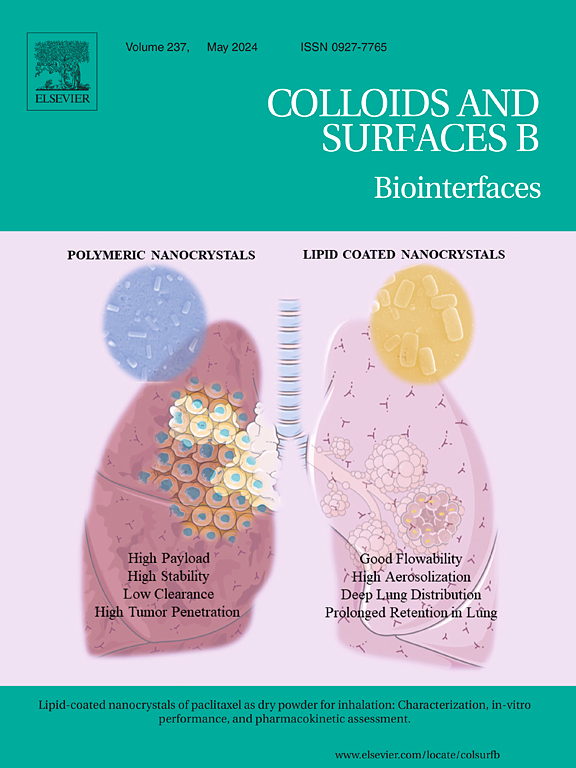Immuno-osteoinductive 3D printed hydrogel scaffolds with triple crosslinking and GA/EGCG release for bone healing
IF 5.4
2区 医学
Q1 BIOPHYSICS
引用次数: 0
Abstract
Bone defects, caused by trauma, osteomyelitis, or osteoporosis, represent a significant global health challenge in orthopedics. However, current bone repair strategies often neglect the critical role of the immune microenvironment, which can impede effective bone regeneration. To address this gap, we developed a 3D-printed triple crosslinked hydrogel scaffold incorporating slow-release glycopyrrolate (GA) and epigallocatechin gallate (EGCG), that it could promote bone regeneration by modulating the immune response. We evaluated their immunomodulatory and bone-regenerative effects through in vitro cellular experiments and rat cranial defect models. Results demonstrated that these scaffolds effectively modulated the immune microenvironment, reducing inflammation while promoting osteoblast differentiation and proliferation, thereby significantly enhancing new bone formation and density. In conclusion, our novel 3D-printed hydrogel scaffold offers a promising approach to bone defect repair through its unique combination of mechanical strength, immunomodulation, and osteogenesis. This study provides valuable insights into leveraging immunomodulatory agents for enhanced bone regeneration, highlighting potential clinical applications.
用于骨愈合的具有三重交联和 GA/EGCG 释放功能的免疫骨诱导性三维打印水凝胶支架
由创伤、骨髓炎或骨质疏松症引起的骨缺损是骨科领域一个重大的全球健康挑战。然而,目前的骨修复策略往往忽视了免疫微环境的关键作用,这可能阻碍有效的骨再生。为了解决这个问题,我们开发了一种3d打印的三重交联水凝胶支架,其中含有缓释甘罗酸酯(GA)和表没食子儿茶素没食子酸酯(EGCG),它可以通过调节免疫反应来促进骨再生。我们通过体外细胞实验和大鼠颅骨缺损模型来评价其免疫调节和骨再生作用。结果表明,这些支架有效调节免疫微环境,减少炎症,促进成骨细胞分化和增殖,从而显著提高新骨的形成和密度。总之,我们的新型3d打印水凝胶支架通过其独特的机械强度、免疫调节和成骨的结合,为骨缺损修复提供了一种很有前途的方法。这项研究为利用免疫调节剂增强骨再生提供了有价值的见解,突出了潜在的临床应用。
本文章由计算机程序翻译,如有差异,请以英文原文为准。
求助全文
约1分钟内获得全文
求助全文
来源期刊

Colloids and Surfaces B: Biointerfaces
生物-材料科学:生物材料
CiteScore
11.10
自引率
3.40%
发文量
730
审稿时长
42 days
期刊介绍:
Colloids and Surfaces B: Biointerfaces is an international journal devoted to fundamental and applied research on colloid and interfacial phenomena in relation to systems of biological origin, having particular relevance to the medical, pharmaceutical, biotechnological, food and cosmetic fields.
Submissions that: (1) deal solely with biological phenomena and do not describe the physico-chemical or colloid-chemical background and/or mechanism of the phenomena, and (2) deal solely with colloid/interfacial phenomena and do not have appropriate biological content or relevance, are outside the scope of the journal and will not be considered for publication.
The journal publishes regular research papers, reviews, short communications and invited perspective articles, called BioInterface Perspectives. The BioInterface Perspective provide researchers the opportunity to review their own work, as well as provide insight into the work of others that inspired and influenced the author. Regular articles should have a maximum total length of 6,000 words. In addition, a (combined) maximum of 8 normal-sized figures and/or tables is allowed (so for instance 3 tables and 5 figures). For multiple-panel figures each set of two panels equates to one figure. Short communications should not exceed half of the above. It is required to give on the article cover page a short statistical summary of the article listing the total number of words and tables/figures.
 求助内容:
求助内容: 应助结果提醒方式:
应助结果提醒方式:


